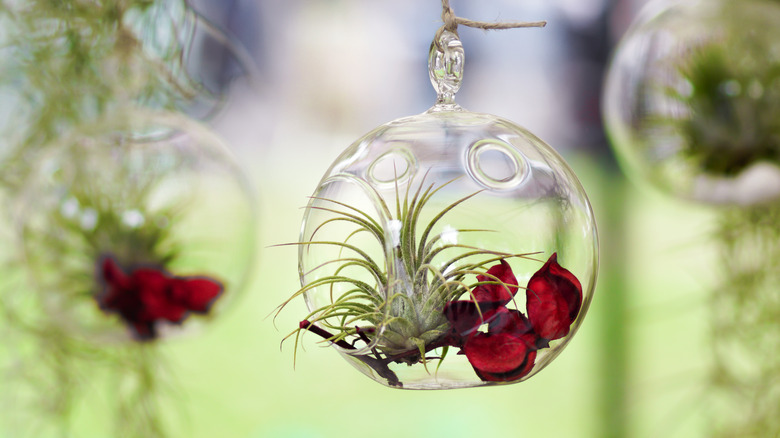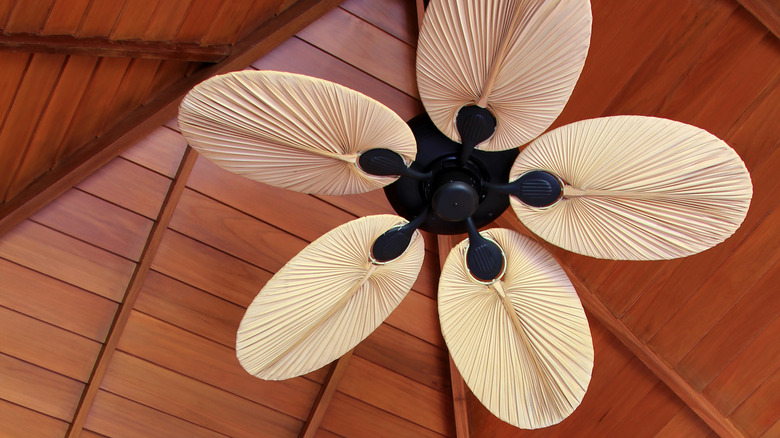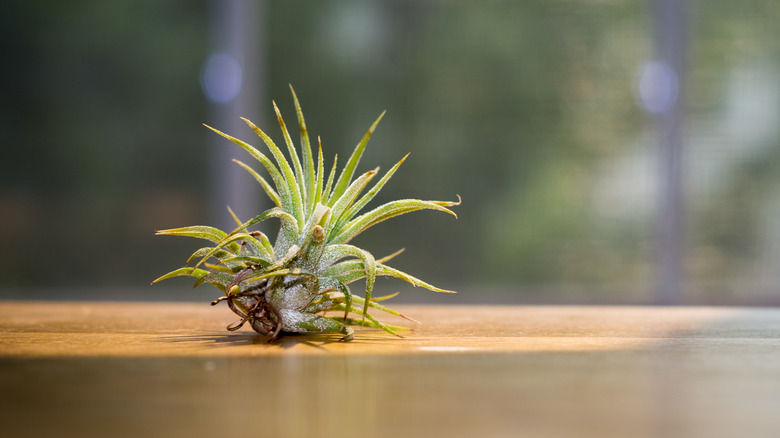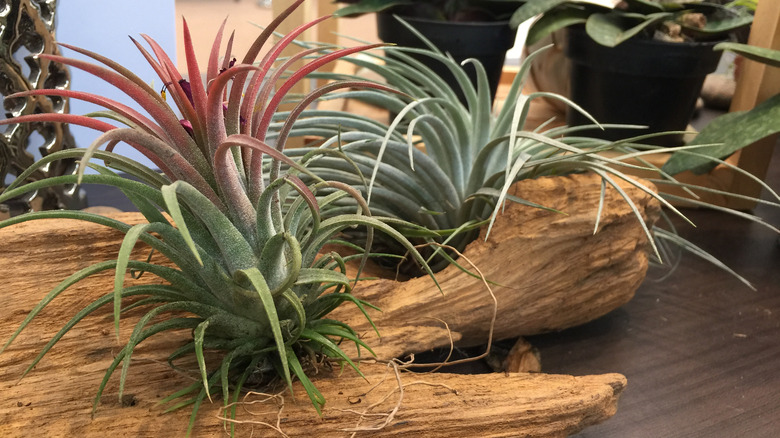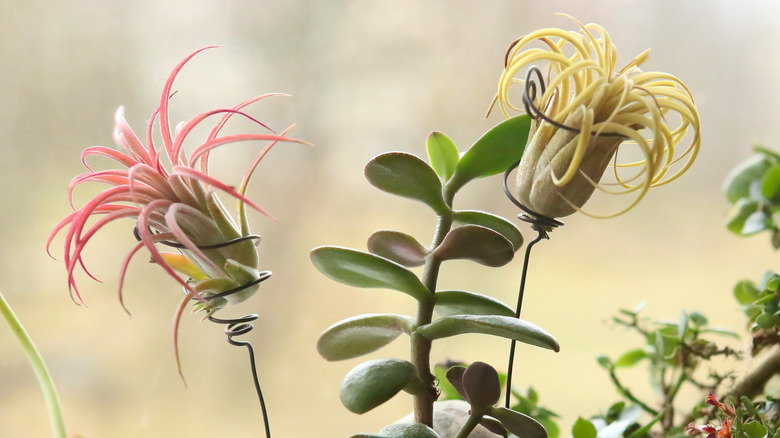5 Easy Ways To Care For Your Air Plants
Tillandsia is a botanical genus containing around 650 species of air plants. These epiphytic delights live off of the oxygen and humidity provided by the air around them, which makes lots of people think they require zero care. Such is not the case, with a simple explanation: The interior environment of your home most likely does not mimic that of the Central and South American mountains and rainforests these little dudes come from.
There are three classifications of tillandsia: hydric, mesic, and xeric. Hydric tillandsia plants come from very wet tropical regions like the Hawaiian rainforests near sea level. They are rare; you're unlikely to see them at your local nursery. Xeric plants are the opposite, originating instead from colder deserts at higher elevations. The New Jersey Agricultural Experiment Station at Rutgers University says they have narrow leaves, which appear to be fuzzy due to an extensive network of trichomes (more on those later).
Nestled in between the two are mesic tillandsia. Hailing from jungle-like forests with moderate humidity, they have upright foliage which is smoother and greener with fewer trichomes.
When it comes down to it, air plants are not difficult to keep alive; they just need a little attention. As Cornell University's Cooperative Extension points out, tillandsia can only be forgiving when they're at least receiving the minimum conditions they require. We've got five easy habits sure to make your indoor air plants happier than epiphytes growing on a liana vine deep within the Amazon.
1. Circulate the air
Considering air plants receive everything they need to survive from the air around them, it's easy to see how air circulation is one of the most crucial aspects of air plant care.
From a biological standpoint, it's not the roots but the trichomes on the leaves of an air plant that allow it to receive life-sustaining nutrients. In fact, if an air plant has any roots at all, they're merely there in the case that the plant wants to hang onto something for stability. As explained by the New Jersey Agricultural Experiment Station, trichomes are made up of a combination of living and dead cells that work together to allow plants to consume moisture and nutrients through osmosis. Not only do they open up to receive the water, they then close to keep it from getting out.
Proper air flow will help the trichomes work efficiently and it will ensure a constant infusion of fresh air transporting oxygen, moisture, and nutrients to your plants.
Be careful not to go overboard here. A tillandsia will not be happy sitting right next to a fan or heating vent, for instance. It will dry out way too quickly. You just want to keep the room from becoming stagnant, which is ultimately a good thing for everyone involved.
2. Let them see the light!
If you can, place or hang your air plant close to a north or south-facing window. Bright yet indirect sunlight is the name of the game when it comes to tillandsia, according to Air Plant Design Studio. That said, it's possible to go too far. If you've got yours in a spot that gets too much scorching direct sunlight, you'll probably notice the leaves drying out and even burning. Filtering the light it receives can help with this. Tillandsia in nature live on trees and vines under a thick canopy of broad leaves, which naturally filter the sunlight before it hits ground level. To mimic this effect, try adding a shear curtain to the window at specific times of the day when the light reaches its peak.
If your plant is outdoors during warmer months, find it a home where it will receive at least partial shading for part of the day from an overhang.
Let's say you want to keep your air plant in a spot that does not receive much natural light — like a cubicle with no windows where you desperately need some sort of connection to nature — you'll need to invest in grow lights to brighten up the area. Note that your standard household lights will be insufficient. Instead, look for LED grow lights optimized for plant growth. This can mean a single bulb, a set of hanging lights, or a more complex system for large rooms and greenhouses.
3. Give 'em a good soak
Since tillandsia get everything they need from proper lighting and air circulation, we don't need to water them, right? Not so much. As with everything else, air plants are chill and easy to care for, but they do need occasional attention in the form of watering. So, your next inquiry might be ... how the heck do we do that if there's no soil?
Great question! Let's go back to the trichomes on the leaves because that's where we need to get the water. There are basically three options. First, increase the humidity in your home upwards of 50% to 70%. If you live in a tropical area, you're probably sweating as you read this and good to go. If not, consider installing a humidifier. Second, grab a clean spray bottle filled only with water and spritz, baby, spritz!
Finally, let 'em soak in a tillandsia-sized tub. You choose the bathtub design — sink, coffee mug, decorative wooden bowl — they're not going to be picky. Air Plant Design Studio recommends a weekly half-hour fully-submerged soak. While you're at it you may as well draw your own relaxing bath and get some homemade spa time in while you can. Just don't accidentally plop your plants into your bubble bath.
After a good soak, air plants need to dry within four hours or they risk suffering from rot. Get them back into that room with the well-circulated air and let the trichomes do their osmosis thing.
4. Keep it cozy
The native habitats of tillandsia plants range from mountains to deserts to forests. They can be found all over Central and South America, as well as the southernmost regions of the United States. Therefore, even though ideal temperatures for these plants have a bit of a range, most of them like to be on the warmer side of things.
According to horticulturists at the New York Botanical Garden, your air plant can survive when it's close to freezing or hitting as high as 100 degrees Fahrenheit, but it will certainly be most successful with relatively warm daytimes temps (65 to 90 F) followed by slightly cooler nighttime temps (50 to 65 F).
Generally speaking, these are guidelines. No need to set thermostat timers or reminder alarms on your phone to turn the temperature down and tuck your tillandsia in before hitting the sheets yourself. Perhaps the Air Plant Shop puts it best when it says, if you're comfortable, so are your plants.
Winter outdoors is a different story. If you live in one of the cooler USDA hardiness zones, it's imperative that your air plants be brought inside whenever the temperature drops. Don't forget that indoor heat can be drying, so do what you can to boost humidity as well. A tray of water left to evaporate into the air next to a plant can help, as can extra bath time and misting.
5. Go easy on the fertilizer
A petite tillandsia resting in a spiral of wire, looking like a floral lollipop shooting out of a larger scheme of houseplants might be the cutest thing ever — besides Dachshund puppies in bathtubs of course — but there's one important factor to consider before mixing the two. Air plants do not need regular fertilizing like the houseplants you may have stuck them in, and too much will be very detrimental.
All this is to say, use caution. The New York Botanical Garden says applying too much fertilizer to a tillandsia is one of the most common errors among houseplant enthusiasts. At best, the result will be scorch marks; at worst, a dying plant. An occasional spray of orchid or bromeliad fertilizer will be more than enough, but you need to use it at a quarter of its regular strength. Also, steer clear of mixtures that contain copper, zinc, or boron.
Before feeding your potted plants at their own regular intervals, either remove any air plants in wire holders from the containers they're displayed in, or simply be very careful to avoid getting any fertilizer on them.
